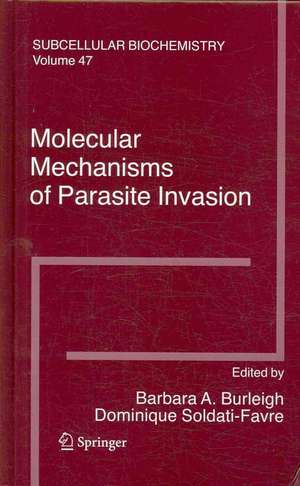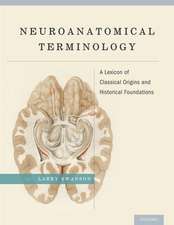Molecular Mechanisms of Parasite Invasion: Subcellular Biochemistry, cartea 47
Editat de Barbara A. Burleigh, Dominique Soldatien Limba Engleză Hardback – 17 apr 2008
| Toate formatele și edițiile | Preț | Express |
|---|---|---|
| Paperback (1) | 1094.25 lei 6-8 săpt. | |
| Springer – 19 noi 2010 | 1094.25 lei 6-8 săpt. | |
| Hardback (1) | 1096.62 lei 6-8 săpt. | |
| Springer – 17 apr 2008 | 1096.62 lei 6-8 săpt. |
Din seria Subcellular Biochemistry
- 18%
 Preț: 948.79 lei
Preț: 948.79 lei - 5%
 Preț: 1456.88 lei
Preț: 1456.88 lei - 18%
 Preț: 1373.84 lei
Preț: 1373.84 lei - 18%
 Preț: 1243.78 lei
Preț: 1243.78 lei - 18%
 Preț: 2098.81 lei
Preț: 2098.81 lei - 18%
 Preț: 1122.10 lei
Preț: 1122.10 lei - 5%
 Preț: 1160.63 lei
Preț: 1160.63 lei - 18%
 Preț: 1396.26 lei
Preț: 1396.26 lei - 18%
 Preț: 1114.96 lei
Preț: 1114.96 lei - 18%
 Preț: 1224.68 lei
Preț: 1224.68 lei - 18%
 Preț: 951.29 lei
Preț: 951.29 lei - 18%
 Preț: 1227.99 lei
Preț: 1227.99 lei -
 Preț: 398.15 lei
Preț: 398.15 lei -
 Preț: 399.88 lei
Preț: 399.88 lei - 18%
 Preț: 1231.47 lei
Preț: 1231.47 lei - 18%
 Preț: 1230.35 lei
Preț: 1230.35 lei -
 Preț: 392.60 lei
Preț: 392.60 lei - 18%
 Preț: 1231.47 lei
Preț: 1231.47 lei - 15%
 Preț: 638.76 lei
Preț: 638.76 lei - 5%
 Preț: 656.26 lei
Preț: 656.26 lei -
 Preț: 389.49 lei
Preț: 389.49 lei - 5%
 Preț: 659.19 lei
Preț: 659.19 lei -
 Preț: 392.37 lei
Preț: 392.37 lei - 5%
 Preț: 662.09 lei
Preț: 662.09 lei -
 Preț: 395.09 lei
Preț: 395.09 lei - 5%
 Preț: 667.99 lei
Preț: 667.99 lei -
 Preț: 400.47 lei
Preț: 400.47 lei - 18%
 Preț: 1224.54 lei
Preț: 1224.54 lei - 15%
 Preț: 647.73 lei
Preț: 647.73 lei - 15%
 Preț: 646.75 lei
Preț: 646.75 lei - 5%
 Preț: 662.30 lei
Preț: 662.30 lei -
 Preț: 395.25 lei
Preț: 395.25 lei - 18%
 Preț: 1230.21 lei
Preț: 1230.21 lei - 18%
 Preț: 1231.95 lei
Preț: 1231.95 lei - 18%
 Preț: 964.54 lei
Preț: 964.54 lei
Preț: 1096.62 lei
Preț vechi: 1154.34 lei
-5% Nou
Puncte Express: 1645
Preț estimativ în valută:
209.90€ • 228.08$ • 176.43£
209.90€ • 228.08$ • 176.43£
Carte tipărită la comandă
Livrare economică 21 aprilie-05 mai
Preluare comenzi: 021 569.72.76
Specificații
ISBN-13: 9780387782669
ISBN-10: 0387782664
Pagini: 237
Ilustrații: XX, 237 p. 52 illus., 4 illus. in color.
Dimensiuni: 165 x 248 x 18 mm
Greutate: 0.48 kg
Ediția:2008
Editura: Springer
Colecția Springer
Seria Subcellular Biochemistry
Locul publicării:New York, NY, United States
ISBN-10: 0387782664
Pagini: 237
Ilustrații: XX, 237 p. 52 illus., 4 illus. in color.
Dimensiuni: 165 x 248 x 18 mm
Greutate: 0.48 kg
Ediția:2008
Editura: Springer
Colecția Springer
Seria Subcellular Biochemistry
Locul publicării:New York, NY, United States
Public țintă
ResearchCuprins
Tools and Experimental Approaches.- Current and Emerging Approaches to Studying Invasion in Apicomplexan Parasites.- Receptor-Ligand Interaction.- Microneme Proteins in Apicomplexans.- Erythrocyte Invasion by Plasmodium falciparum: Multiple Ligand-Receptor Interactions and Phenotypic Switching.- Role of the gp85/Trans-Sialidase Superfamily of Glycoproteins in the Interaction of Trypanosoma cruzi with Host Structures.- Signaling Pathways.- Calcium Regulation and Signaling in Apicomplexan Parasites.- Trypanosoma cruzi: Parasite and Host Cell Signaling during the Invasion Process.- Actin Dynamics: Host and Parasite.- Host Cell Actin Remodeling in Response to Cryptosporidium.- Host Cell Actin Remodeling in Response to Trypanosoma cruzi: Trypomastigote Versus Amastigote Entry.- Actin/Myosin-Based Gliding Motility in Apicomplexan Parasites.- Proteases.- Roles of Proteases during Invasion and Egress by Plasmodium and Toxoplasma.- Roles of Naturally Occurring Protease Inhibitors in the Modulation of Host Cell Signaling and Cellular Invasion by Trypanosoma cruzi.- The Parasitophorous Vacuole.- Biogenesis of and Activities at the Toxoplasma gondii Parasitophorous Vacuole Membrane.- The Role of Host Cell Lysosomes in Trypanosoma cruzi Invasion.- Leishmania Invasion and Phagosome Biogenesis.- Penetrating Biological Barriers.- Plasmodium Sporozoite Passage across the Sinusoidal Cell Layer.- Transepithelial Migration by Toxoplasma.- The Microsporidian Polar Tube and Its Role in Invasion.- Intestinal Invasion by Entamoeba histolytica.
Recenzii
From the reviews:
"An environment in which there is extensive knowledge of the DNA, RNA and protein of key parasites and of human cells. … Readers of this book will discover that while many of the exact mechanisms … adopted by different parasites. As someone working in this field I found this book enormously interesting and useful … . Active researchers and PhD students in this and affiliated fields will no doubt find this an essential resource for several years … ." (Kevin M. Tyler, Parasites and Vectors, Issue 2, May, 2009)
"An environment in which there is extensive knowledge of the DNA, RNA and protein of key parasites and of human cells. … Readers of this book will discover that while many of the exact mechanisms … adopted by different parasites. As someone working in this field I found this book enormously interesting and useful … . Active researchers and PhD students in this and affiliated fields will no doubt find this an essential resource for several years … ." (Kevin M. Tyler, Parasites and Vectors, Issue 2, May, 2009)












